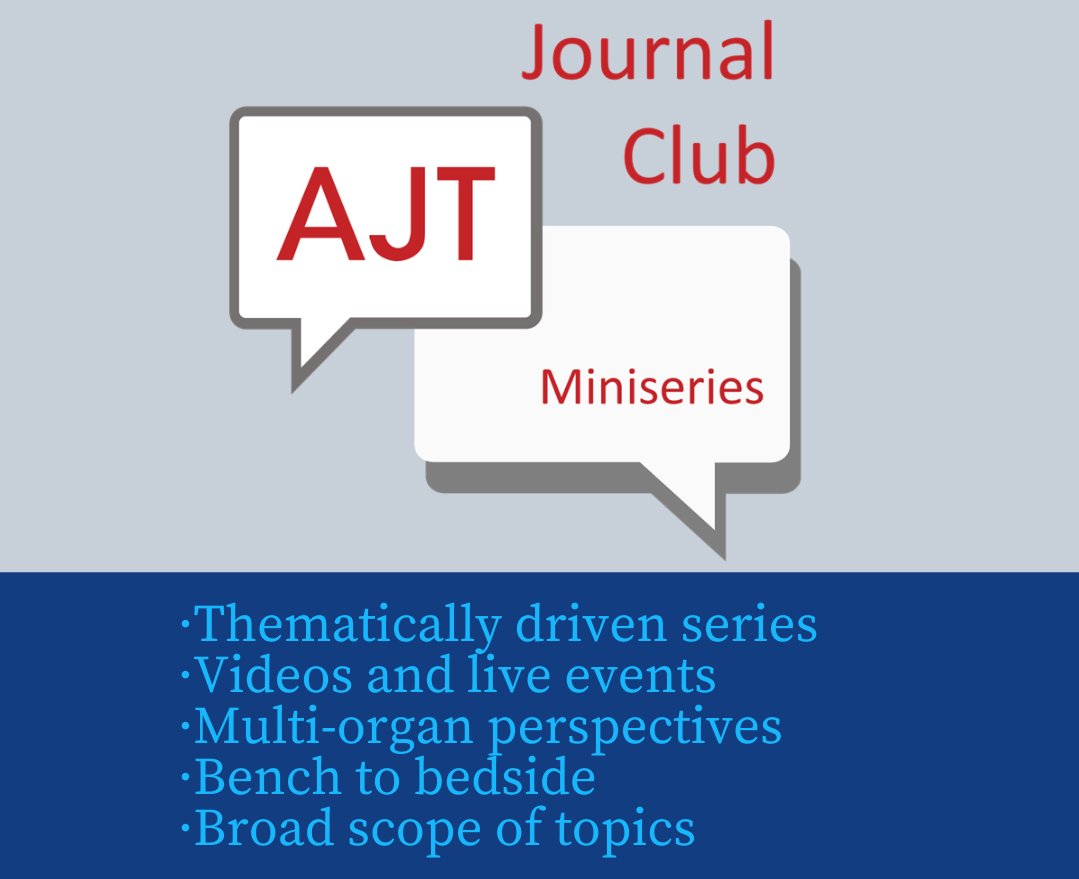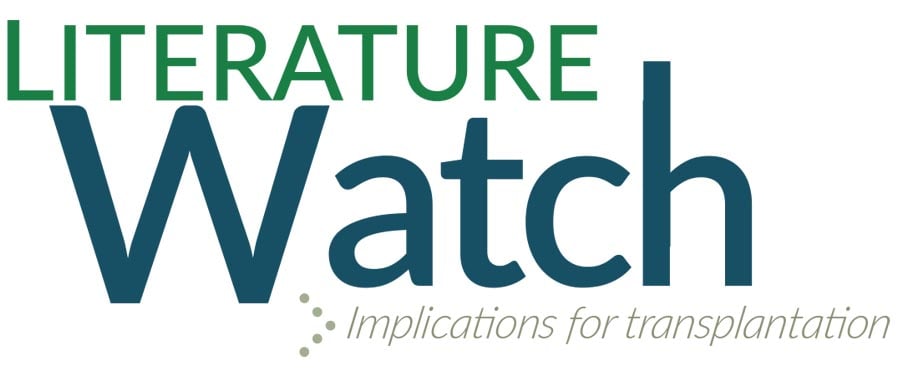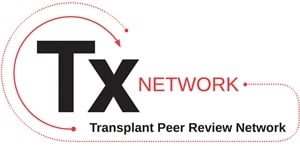Journal list menu
Export Citations
Download PDFs
Editorials
Lack of Interventional Studies in Renal Transplant Candidates with Elevated Cardiovascular Risk
- Pages: 493-494
- First Published: 22 January 2007
Although analysis of registry data is useful, the effectiveness of interventions to reduce risk cannot be predicted with confidence from such analyses, and will require prospective intervention studies. See also article by Schold et al in this issue on page 550.
Lessons from the CAESAR Study: Calcineurin Inhibitors—Can't Live with Them and Can't Live without Them
- Pages: 495-496
- First Published: 07 February 2007
Drawing conclusions from the CAESAR study is complicated by the poor tolerance of the calcineurin inhibitor avoidance and withdrawal arms, leaving difficulties with intention-to-treat analysis because many calcineurin inhibitor-free patients are actually still on these agents. See also article by Ekberg et al in this issue on page 560.
Organ Donation: The Gift, the Weight and the Tyranny of Good Acts
- Pages: 497-498
- First Published: 27 February 2007
In this Editorial the authors offer a counterpoint to the views expressed by Scheper-Hughes in this issue on page 507. The authors emphasize that one must be careful in taking extreme examples as a basis for judging the complex continuum of motivations, sacrifices and burdens that a donor inevitably must face.
Minireviews
The Interface Between Coagulation and Immunity
- Pages: 499-506
- First Published: 04 January 2007
The complex proteases of the coagulation system have roles in hemostasis and thrombosis, but may also be important in response to injury, inflammation, scarring, and adaptive immunity.
Ethics Corner
The Tyranny of the Gift: Sacrificial Violence in Living Donor Transplants
- Pages: 507-511
- First Published: 22 January 2007
The author argues that the rise in living donation has not been associated with sufficient attention to the pressures on the donors, such as the sense of obligation felt by children to forfeit a kidney for an elderly parent. See also editorial by Kaplan and Williams in this issue on page 497.
Meeting Reports
Protocol Biopsies in Renal Transplantation: Insights into Patient Management and Pathogenesis
- Pages: 512-517
- First Published: 22 January 2007
Protocol biopsies in kidney transplantation are safe and can yield unique information, but would be more widely used if the efficacy of interventions based on biopsy findings could be established.
Banff '05 Meeting Report: Differential Diagnosis of Chronic Allograft Injury and Elimination of Chronic Allograft Nephropathy (‘CAN’)
- Pages: 518-526
- First Published: 27 February 2007
The Banff consensus process has now eliminated the use of the term “chronic allograft nephropathy” (CAN) and replaced it with specific terms that distinguish non-specific atrophy and fibrosis from specific entities such as slow antibody-mediated rejection.
Original Articles:
Basic Science
Beneficial Effects of CCR1 Blockade on the Progression of Chronic Renal Allograft Damage
- Pages: 527-537
- First Published: 04 January 2007
Blockade of the chemokine receptor CCR1 leads to a significant reduction of glomerulosclerosis and allograft fibrosis in rat renal allografts associated with a decrease of leukocyte infiltration of the graft and a direct inhibition of matrix synthesis.
Functional Compartmentalization Following Induction of Long-Term Graft Survival with Pregraft Donor-Specific Transfusion
- Pages: 538-549
- First Published: 11 January 2007
In this rat heart transplant model, splenocytes and spleen T cells from treated recipients transferred long-term graft survival but blood T cells did not. Spleen T cells nevertheless are not able to prevent chronic rejection.
Clinical Science
A ‘Weight-Listing’ Paradox for Candidates of Renal Transplantation?
- Pages: 550-559
- First Published: 06 December 2006
Although high BMI on the wait list is a risk factor for kidney transplant recipients, this retrospective analysis of USRDS data found no evidence that weight loss before transplantation is associated with improved transplant outcomes. See also editorial by Schnitzler et al in this issue on page 493.
Cyclosporine Sparing with Mycophenolate Mofetil, Daclizumab and Corticosteroids in Renal Allograft Recipients: The CAESAR Study
- Pages: 560-570
- First Published: 04 January 2007
In this multicenter study, reduced cyclosporine exposure (but not CsA withdrawal) in combination with mycophenolate mofetil, daclizumab and corticosteroids was a safe and effective regimen. However, renal function was not improved compared to the control group of standard cyclosporine at 12 months. See also editorial by Kaplan and Budde in this issue on page 495.
Donation after Cardiac Death Kidneys with Low Severity Pre-Arrest Acute Renal Failure
- Pages: 571-575
- First Published: 27 February 2007
Using RIFLE criteria to define severity of acute renal failure, this study found that kidneys from controlled Non-Heart Beating donors with low severity pre-arrest acute renal failure can be transplanted.
Subclinical Acute Antibody-Mediated Rejection in Positive Crossmatch Renal Allografts
- Pages: 576-585
- First Published: 04 January 2007
Ten of 83 patients receiving an HLA-incompatible renal allograft following desensitization had a protocol biopsy showing histologic and immunohistologic changes of acute antibody-mediated rejection (AMR); follow-up biopsies of these grafts taken a mean of ∼1 year later showed significantly more chronic change, including glomerulopathy, than biopsies of 24 HLA-incompatible grafts with no history of AMR over a similar interval.
Mycophenolate Mofetil/Sirolimus Compared to Other Common Immunosuppressive Regimens in Kidney Transplantation
- Pages: 586-594
- First Published: 04 January 2007
Retrospective analysis of SRTR recipients receiving sirolimus plus mycophenolate revealed that, compared with other commonly used regimens, this combination was associated with higher rejection rates and lower graft survival, as well as increased delayed graft function in deceased donor transplants.
One-Year Results with Extended-Release Tacrolimus/MMF, Tacrolimus/MMF and Cyclosporine/MMF in De Novo Kidney Transplant Recipients
- Pages: 595-608
- First Published: 11 January 2007
Six hundred and thirty-eight (638) de novo kidney patients participated in this phase III randomized open-label trial. In patients also given corticosteroids and basiliximab, extended release tacrolimus plus MMF was similar in safety and efficacy to conventional tacrolimus/MMF and to cyclosporine/MMF.
Improved Outcomes of Renal Transplantation from Cardiac Death Donors: A 30-Year Single Center Experience
- Pages: 609-617
- First Published: 11 January 2007
In 256 recipients with renal allografts from cardiac death donors between 1975 and 2004 at a single center, delayed graft function was frequent (72%), but graft survival rates have continually improved, confirming the utility of this source of kidney transplants.
Urinary Albumin Excretion and the Risk of Graft Loss and Death in Proteinuric and Non-proteinuric Renal Transplant Recipients
- Pages: 618-625
- First Published: 11 January 2007
In renal transplant patients, microalbuminuria and macroalbuminuria are risk factors for graft loss, even after adjusting for renal function and diabetes, and also predict increased risk of patient death.
Pretransplant Risk Assessment in Renal Allograft Recipients Using Virtual Crossmatching
- Pages: 626-632
- First Published: 27 February 2007
This prospective study evaluated virtual crossmatching for pre-transplant risk assessment in renal allograft recipients and correlated these results with clinical and histopathological outcomes as well as retrospectively obtained flow-cytometric crossmatches. The results indicate that the virtual crossmatch accurately detects donor-specific antibody.
Immunogenicity of Pneumococcal Vaccine in Renal Transplant Recipients—Three Year Follow-up of a Randomized Trial
- Pages: 633-638
- First Published: 11 January 2007
This randomized study of pneumococcal conjugate vaccine PCV7 compared to the current standard pneumococcal polysaccharide vaccine PPV23 found that the PCV7 did not enhance the durability of the response.
Immunosuppression for Dual Kidney Transplantation with Marginal Organs: The Old Is Better Yet
- Pages: 639-644
- First Published: 11 January 2007
This study comparing two immunosuppressive protocols in patients receiving dual kidney transplants from extended criteria donors found that a protocol with rATG and sirolimus offered no advantages over a cyclosporine-based protocol.
Body Mass Index and Glomerular Hyperfiltration in Renal Transplant Recipients: Cross-Sectional Analysis and Long-Term Impact
- Pages: 645-652
- First Published: 22 January 2007
This study of the relationship between recipient BMI and renal hemodynamics one year post-transplant found that higher recipient BMI is associated with higher GFR and filtration fraction.
Risk Factors for Hospitalization for Bacterial or Viral Infection in Renal Transplant Recipients—An Analysis of USRDS Data
- Pages: 653-661
- First Published: 22 January 2007
The risk of hospitalization for virus infection post-transplant is increased in young recipients with CMV positive kidneys, whereas hospitalization for bacterial infection was associated with delayed graft function, previous chronic pyelonephritis, pre-transplant diabetes, and female gender.
Younger Age and Antibody Induction Increase the Risk for Infection in Pediatric Renal Transplantation: A NAPRTCS Report
- Pages: 662-666
- First Published: 22 January 2007
Antibody induction therapy, especially in younger children, increased the risk for hospitalization for viral or bacterial infection, without improvements in patient or graft survival.
Intravenous Iloprost: A New Therapeutic Option for Patients with Post-Transplant Distal Limb Syndrome (PTDLS)
- Pages: 667-671
- First Published: 11 January 2007
Prostacyclin analogue iloprost rapidly relieved symptoms in patients with post transplant distal limb syndrome (PTDLS) giving new insights into the potential cause of this syndrome and suggesting new therapeutic option in severely affected patients.
Preoperative Volume Prediction in Adult Living Donor Liver Transplantation: How Much Can We Rely on It?
Essen Experience Based on Virtual Three-dimensional Computed Tomography-Volume Assessment
- Pages: 672-679
- First Published: 04 January 2007
3D CT volumetry based on the “largest” (venous) CT phase is associated with considerable overestimation of the pre-operative liver volume, whereas volumetry based on the “smallest” (native) CT phase accurately matches the intraoperative findings.
Liver Transplantation from Deceased Donors Serologically Positive for Chagas Disease
- Pages: 680-684
- First Published: 11 January 2007
TIn six patients receiving liver transplants from deceased donors serologically positive for Chagas disease, none developed evidence of Chagas disease when prophylactic treatment with benznidazole was used.
Female Liver Transplant Recipients with the Same GFR as Male Recipients Have Lower MELD Scores—A Systematic Bias
- Pages: 685-692
- First Published: 11 January 2007
The failure to accurately estimate the male-female difference in GFRs in calculating the MELD scores may operate as a bias against females in liver transplant allocation.
Genetic Regulation of Rejection and Survival Following Human Lung Transplantation by the Innate Immune Receptor CD14
- Pages: 693-699
- First Published: 11 January 2007
Patients who received lung transplants and had the TT genotype for the CD14-159 polymorphism displayed more rejection and BOS and worse graft survival.
Recipient Vascular Endothelial Growth Factor Serum Levels Predict Primary Lung Graft Dysfunction
- Pages: 700-706
- First Published: 22 January 2007
Pre-operative serum VEGF concentrations were significantly higher in patients whose lung transplants subsequently manifested primary graft dysfunction.
Brief Communications
Human Islet Oxygen Consumption Rate and DNA Measurements Predict Diabetes Reversal in Nude Mice
- Pages: 707-713
- First Published: 04 January 2007
When combined, the total viable amount and the fractional viability of transplanted human islet tissue, estimated based on Oxygen Consumption Rate and DNA measurements, predict diabetes reversal in diabetic nude mice and thus can be used as a real-time predictor islet potency assay.
Clobetasol Ameliorates Aphthous Ulceration in Renal Transplant Patients on Sirolimus
- Pages: 714-717
- First Published: 22 January 2007
The potent topical steroid clobetasol applied to oral ulcers associated with sirolimus therapy can lead to prompt resolution of the ulcers.
Case Reports
Familial Hypocalciuric Hypercalcemia in the Donor and Recipient of a Living Related Donor Kidney Transplant
- Pages: 718-721
- First Published: 11 January 2007
This patient with familial hypocalcuric hypercalcemia (FHH) received a living donor kidney transplant from her FHH-affected daughter, with an excellent post-transplant outcome.
Hyperammonemia in Generalized Mycobacterium genavense Infection after Renal Transplantation
- Pages: 722-723
- First Published: 22 January 2007
Fatal disseminated infection with Mycobacterium genevense in a renal transplant patient was associated with hyperammonemia and impaired consciousness, raising the possibility that urease by the organism may have contributed to ammonia production.
Letters to the Editor
C4d and C3d Staining in Biopsies of ABO- and HLA-Incompatible Renal Allografts: Correlation with Histologic Findings
- Page: 724
- First Published: 04 January 2007
The Institute of Medicine Report: Sensible and Consequential
- Pages: 725-726
- First Published: 04 January 2007
Response to ‘The Institute of Medicine Report: Sensible and Consequential’
- Page: 727
- First Published: 27 February 2007
Impact of Recipient Age on the Long-Term Outcome of Living Donor Liver Transplantation for Post-Kasai Biliary Atresia
- Page: 728
- First Published: 27 February 2007










.jpg)
